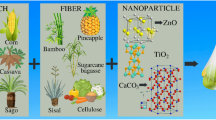Abstract
In this research, cellulases were immobilized on Eudragit S-100 to minimize the tensile strength loss of cotton fabric caused by the enzymatic hydrolysis. About 76 % of the enzyme activity and 81 % of the amount of protein were recovered after the immobilization process, and the immobilized cellulase exhibited good reuse ability. The immobilized cellulase had the better adsorptive performance on cotton than the free cellulase. In addition, the results revealed that the catalytic efficiency of the immobilized cellulase on cotton was degradation, perhaps because the diffusion of the enlarged cellulase molecules is significantly inhibited in the interior of the cotton fiber. Moreover, the cotton fabric treated with the immobilized cellulase showed less weight and strength losses. SEM pictures further indicated that the cotton fabric treated with the immobilized cellulase suffered less damage.
Similar content being viewed by others
Refrerences
P. Wang, Q. Wang, L. Cui, M. Gao, and X. Fan, Fiber. Polym., 6, 12 (2011).
E. Karanikas, C. Kosolia, M. Zarkogianni, N. Nikolaidis, and E. Tsatsaroni, Fiber. Polym., 2, 14 (2013).
L. Cui, P. Wang, Q. Wang, and X. Fan, Fiber. Polym., 4, 10 (2009).
S. Lee, W. Song, and H. Kim, Fiber. Polym., 6, 10 (2009).
N. Ibrahim, M. El-Hossamy, M. Hashem, R. Refai, and B. Eid, Carbohyd. Polym., 4, 74 (2008).
A. Aly, A. Moustafa, and A. Hebeish, J. Clean. Prod., 7, 12 (2004).
H. Belghiht, S. Ellouz-Chaabouni, and A. Gargouri, J. Biotechnol., 2-3, 89 (2009).
A. Cavaco-Paulo, L. Almeida, and D. Bishop, AATCC Rev., 6, 28 (1996).
M. Hashem and N. Ibrahim, J. Text. Association, 11-12, 63 (2002).
L. Hao, R. Wang, J. Liu, and R. Liu, Carbohyd. Polym., 1, 89 (2012).
A. Hebeish and N. Ibrahim, Colourage, 4, 54 (2007).
N. Ibrahim, K. EL-Badry, B. Eid, and T. Hassan, Carbohyd. Polym., 1, 83 (2011).
L. Fan, Y. Lee, and D. Beardmore, “Advances in Biochemical Engineering”, Springer-Verlag, Berlin, 1980.
H. Lenting and M. Warmoeskerken, J. Biotechnol., 2-3, 89 (2001).
M. Fujii and M. Taniguchi, Trends. Biotechnol., 1, 9 (1991).
A. Rodrigues, J. Cabral, and M. Taipa, Enzyme. Microb. Tech., 1-2, 31 (2002).
J. Shen, M. Rushforth, A. Cavaco-Paulo, G. Guebitz, and H. Lenting, Enzyme. Microb. Tech., 7, 40 (2007).
E. Smith, M. Schroeder, G. Guebitz, and J. Shen, Enzyme. Microb. Tech., 3, 47 (2010).
R. Wang, J. Kim, B. Kim, C. Park, and S. Yoo, Bioresource Technol., 10, 102 (2011).
Y. Yu, J. Yuan, Q. Wang, X. Fan, and P. Wang, Appl. Biochem. Biotech., 6, 166 (2012).
A. Kondo, T. Urabe, and K. Higashitani, J. Ferment. Bioeng., 6, 77 (1994).
M. Sardar, R. Agarwal, A. Kumar, and M. Gupta, Enzyme. Microb. Tech., 5, 20 (1997).
Y. Yu, J. Yuan, Q. Wang, X. Fan, P. Wang, and X. Sun, Eng. Life. Sci., 2, 13 (2013).
S. Lee, H. Shin, D. Ryu, and M. Mandels, Biotechnol. Bioeng., 10, 24 (1982).
F. Daoud, S. Kaddour, and T. Sadoun, Colloid. Surface. B., 1, 75 (2010).
Author information
Authors and Affiliations
Corresponding author
Rights and permissions
About this article
Cite this article
Yu, Y., Yuan, J., Wang, Q. et al. A promising approach for bio-finishing of cotton using immobilized acid-cellulase. Fibers Polym 15, 932–937 (2014). https://doi.org/10.1007/s12221-014-0932-2
Received:
Revised:
Accepted:
Published:
Issue Date:
DOI: https://doi.org/10.1007/s12221-014-0932-2




